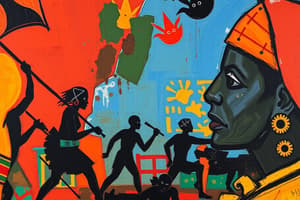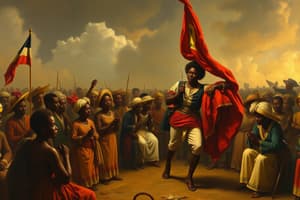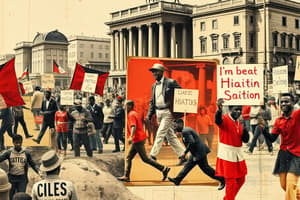Podcast
Questions and Answers
Who was the leader associated with the Pan-Americanism Movement?
Who was the leader associated with the Pan-Americanism Movement?
- José de San Martín
- Agustín de Iturbide
- Miguel Hidalgo
- Simón Bolívar (correct)
Which revolutionary leader fought for independence in southern Spanish colonies?
Which revolutionary leader fought for independence in southern Spanish colonies?
- Dom Pedro
- Simón Bolívar
- Miguel Hidalgo
- José de San Martín (correct)
What event marked the beginning of Miguel Hidalgo's call for Mexican independence?
What event marked the beginning of Miguel Hidalgo's call for Mexican independence?
- The Peninsular War
- The overthrow of Iturbide
- The installation of Dom Pedro
- The Grito de Dolores (correct)
What happened in Brazil after the Portuguese king returned to Portugal?
What happened in Brazil after the Portuguese king returned to Portugal?
Which of the following nations is NOT one of the original countries formed from Central American independence?
Which of the following nations is NOT one of the original countries formed from Central American independence?
What was a significant outcome of the Latin American Revolutions regarding governance?
What was a significant outcome of the Latin American Revolutions regarding governance?
What economic policy trend emerged in Latin America following the revolutions?
What economic policy trend emerged in Latin America following the revolutions?
What was the fate of Central American nations after their declaration of independence in 1821?
What was the fate of Central American nations after their declaration of independence in 1821?
Who led the Haitian Revolution after Toussaint L’Ouverture?
Who led the Haitian Revolution after Toussaint L’Ouverture?
What significant event occurred in Haiti as a result of the Haitian Revolution?
What significant event occurred in Haiti as a result of the Haitian Revolution?
Which group in the Spanish colonies were European born individuals appointed to govern?
Which group in the Spanish colonies were European born individuals appointed to govern?
What was a key outcome of the Peninsular War for the Latin American colonies?
What was a key outcome of the Peninsular War for the Latin American colonies?
What Enlightenment idea motivated many Creoles in Latin America?
What Enlightenment idea motivated many Creoles in Latin America?
What term describes the mixed-race individuals of Indigenous and European descent in the Spanish colonies?
What term describes the mixed-race individuals of Indigenous and European descent in the Spanish colonies?
Which of the following best describes Haiti's initial governance post-independence?
Which of the following best describes Haiti's initial governance post-independence?
Which group in the social structure of Spanish colonies was at the bottom and included enslaved people from Africa?
Which group in the social structure of Spanish colonies was at the bottom and included enslaved people from Africa?
Flashcards
Toussaint L’Ouverture
Toussaint L’Ouverture
Leader of the Haitian Revolution, formerly enslaved, inspired by Enlightenment ideas.
Jean-Jacques Dessalines
Jean-Jacques Dessalines
Leader who declared Haiti's independence from France in 1804 after L’Ouverture.
Haitian Revolution
Haitian Revolution
The first successful slave revolt, led by L’Ouverture and Dessalines, ending slavery in Haiti.
Enlightenment Ideas
Enlightenment Ideas
Signup and view all the flashcards
Creoles
Creoles
Signup and view all the flashcards
Peninsulares
Peninsulares
Signup and view all the flashcards
Mestizos and Mulattos
Mestizos and Mulattos
Signup and view all the flashcards
Peninsular War
Peninsular War
Signup and view all the flashcards
Simón Bolívar
Simón Bolívar
Signup and view all the flashcards
Gran Colombia
Gran Colombia
Signup and view all the flashcards
José de San Martín
José de San Martín
Signup and view all the flashcards
Padre Miguel Hidalgo
Padre Miguel Hidalgo
Signup and view all the flashcards
Agustín de Iturbide
Agustín de Iturbide
Signup and view all the flashcards
Brazil's Independence
Brazil's Independence
Signup and view all the flashcards
Central American Independence
Central American Independence
Signup and view all the flashcards
Impact of Latin American Revolutions
Impact of Latin American Revolutions
Signup and view all the flashcards
Study Notes
Haitian Revolution (1791-1804)
- Toussaint L'Ouverture, born enslaved in St. Domingue (Haiti), led a slave revolt.
- The revolt ended slavery in Haiti (1791-1801).
- L'Ouverture was inspired by Enlightenment ideas.
- Napoleon imprisoned L'Ouverture in 1802, and sent troops to reinstate slavery.
Haitian Revolution Continued
- Jean-Jacques Dessalines led the revolution after L'Ouverture.
- Dessalines declared Haiti independent from France in 1804.
- Haiti became the first nation in the Americas ruled by Black leaders.
- Haiti was the first nation to abolish slavery in the Americas.
- Haiti faced political and economic opposition from European nations and the U.S.
Latin America Under Spanish & Portuguese Rule (1492-early 1800s)
- Spain & Portugal appointed European-born men to rule colonial governments.
- Latin American colonies paid high taxes and supplied materials (silver, sugar) to Spain and Portugal.
Class Structure in Spanish Colonies
- Peninsulares: Born in Spain, top government officials and landowners.
- Creoles: Born in America, Spanish ethnicity, military officers and landowners.
- Mestizos: Mixed-race (Indigenous and European).
- Mulattos: Mixed-race (African and European).
- Enslaved people: From Africa and those born into slavery in the Americas.
- Indigenous people: Includes Genízaros, Native Americans sold into slavery by Spanish colonists in the present-day Southwest.
Latin American Revolutions & French Revolution (1804-1814)
- Creoles: American-born landowners, educated in Europe, learned Enlightenment ideas, wanted political power.
- Peninsular War: France occupied Spain and Portugal, replacing their kings with Napoleon's family members, weakening Spanish control over Latin American colonies.
- Creole Revolt: Creoles revolted because they felt no loyalty to Napoleon's puppet government.
- The Portuguese royal family fled to Brazil.
South American Independence & Revolutionary Leaders (1802-1820s)
- Simón Bolívar: A Venezuelan creole, wealthy landowner, educated in Europe, led the Pan-Americanism Movement; wanted a united Latin American state.
- Bolívar obtained independence for Venezuela, Columbia, Panama, Ecuador, and Peru (forming Gran Colombia, 1819-1830).
- He expanded his army to include mestizos and Indigenous troops to fight Spanish troops.
South American Revolutions Continued
- José de San Martín: An Argentine creole, wealthy, educated in Europe, fought for independence for southern Spanish colonies.
- San Martín joined forces with Bolívar to gain independence for Argentina, Chile, and Peru (1812-1822).
Mexican Revolution for Independence (1811-1821)
- Padre Miguel Hidalgo: A priest, led a peasant revolution for Mexican independence involving mestizos and Indians.
- Grito de Dolores: Hidalgo rang church bells to gather revolutionaries.
- Creoles joined the revolution in 1821 after fearing loss of status (landownership and political power).
- Agustín de Iturbide, a Creole, proclaimed himself emperor.
Brazil & Central American Independence (1821-1822)
- Portuguese King fled to Brazil during the Peninsular War against Napoleon.
- Brazilian King returned to Portugal after Napoleon's defeat.
- In 1822, Brazilians petitioned for independence and installed Dom Pedro, the son of the Portuguese king, as their ruler.
- Central American nations declared independence from Spain in 1821.
- In 1823, these nations finalized independence from Mexico after Iturbide was overthrown.
- The Central American nations formed the United Provinces of Central America, but later separated into independent nations.
Impact of Latin American Revolutions
- Consent of the Governed: Creole landowning class maintained control over the new governments.
- Dictatorships & Military Coups: Dictatorships and military coups shaped Latin American politics.
- Economic Policies: Favoritism towards wealthy elites resulted in large wealth gaps.
- Demands for Ranch Land: Demands for ranch land led to deforestation of rainforests.
- Colonial European Ideology: Colonial European ideology of white supremacy continued to influence discrimination against Indigenous and Black Latin Americans.
Additional Information
- 2024 Venezuelan Election: Issues/controversies with the election process were noted.
- 2021 Chilean Constitution: Chile's new constitution was written, confronting climate change head-on.
- 2013 Colombia, Venezuela, Peru, & Mexico: Video analysis noted opportunities, challenges, and links to the colonial past.
Studying That Suits You
Use AI to generate personalized quizzes and flashcards to suit your learning preferences.




